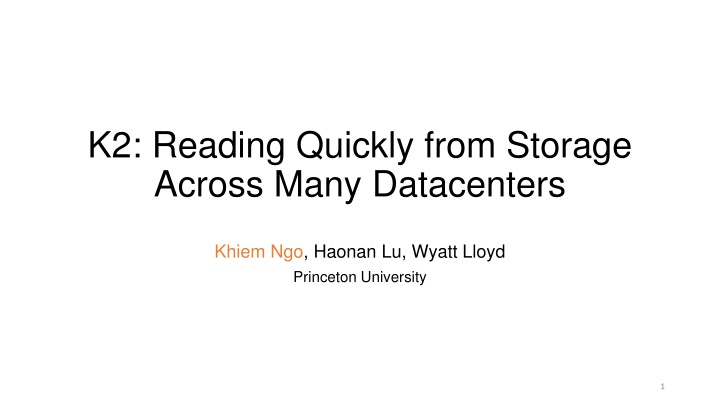Efficient Datacenter Deployment Strategies for Low Latency
Explore the strategies for deploying services across multiple datacenters to reduce end-user latency. Topics include the impact of replication levels, benefits of partial replication, and achieving low latency with strong guarantees like causal consistency and read-only/write-only transactions.
Download Presentation

Please find below an Image/Link to download the presentation.
The content on the website is provided AS IS for your information and personal use only. It may not be sold, licensed, or shared on other websites without obtaining consent from the author.If you encounter any issues during the download, it is possible that the publisher has removed the file from their server.
You are allowed to download the files provided on this website for personal or commercial use, subject to the condition that they are used lawfully. All files are the property of their respective owners.
The content on the website is provided AS IS for your information and personal use only. It may not be sold, licensed, or shared on other websites without obtaining consent from the author.
E N D
Presentation Transcript
K2: Reading Quickly from Storage Across Many Datacenters Khiem Ngo, Haonan Lu, Wyatt Lloyd Princeton University 1
Web Services Span Across Datacenters Large-scale services deploy across many datacenters 2
Web Services Span Across Datacenters Medium-scale services often deploy across a few datacenters (optionally) deploy across many datacenters 3
Deploying across many datacenters potentially reduces end- user latency A Few vs. Many 4
Deploying Across Many Datacenters Discourages Full Replication 5
Deploying Across Many Datacenters Necessitates Partial Replication 6
Nave Partial Replication Hurts Latency Multiple round-trips lead to higher latency Storage Guarantees Complicate Matters vs. fully replicating across a few datacenters 7
K2: Partial Replication + Low Latency + Guarantees Causal consistency, read-only and write-only transactions Compatible with low latency Suitable for many applications K2 unlocks the low latency benefit of many datacenters for these strong guarantees 8
K2s Design Goals At most 1 round of non-blocking cross-datacenter requests Latency no worse than fully replicating across a few datacenters Often 0 cross-datacenter requests Low latency for most requests 9
Replication Design Metadata replication: Fully replicate metadata Partially replicate data At most 1 cross-dc round Constrained replication topology Replicated write-only transaction algorithm Non-blocking 10
Cache-Aware Read-only Transaction Small cache in each datacenter Often 0 cross-dc rounds Maximize ability to reuse cached values Ensure consistency and isolation 11
Evaluation Does K2 provide read latency improvement? Write latency, throughput, and staleness? Emulate 6 datacenters spread around the world Baselines Replicas Across Datacenters (RAD) PaRiS* 12
K2 Achieves Lower Latency 0 cross-dc rounds for 60% of txns 1 cross-dc round 2 cross-dc rounds 13
Contact Information: Khiem Ngo khiem@princeton.edu Conclusion Realizing the low latency benefit of many datacenters is complicated by partial replication and storage guarantees K2: partially-replicated storage system that unlocks low latency for the strong guarantees of Causal consistency, read-only and write-only transactions K2 has lower latency than the baselines in all settings 14























